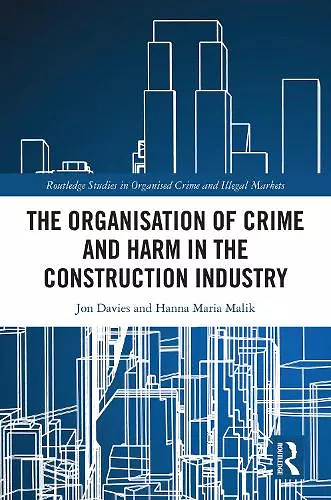The Organisation of Crime and Harm in the Construction Industry
Jon Davies author Hanna Malik author
Format:Hardback
Publisher:Taylor & Francis Ltd
Published:30th Apr '24
Currently unavailable, and unfortunately no date known when it will be back

Drawing on empirical work and secondary analysis from the UK and Finnish construction industries, this book contributes a deep-rooted analysis of construction industry harms that originate from corporate-industrialstate processes.
The UK context arguably represents a classic ‘neoliberal’ system categorised by privatisation of services and minimal regulation, whereas Finland broadly provides a ‘social democratic’ alternative with its relatively strong national regulation and public sector oversight of industry. These concepts interlink strongly with the notion of state-corporate crime, since this perspective shifts attention away from individualistic explanations for crime and harm towards symbiosis between states and corporations. This book argues that existing explanations based on organised crime and individual ‘rogues’ are insufficient to account for the wider range and subtlety of harms that occur in construction, and therefore offers a unique perspective into organisational, industry, and state dynamics in this sector.
An accessible and compelling read, this book will appeal to students and scholars of criminology, sociology, organized crime, and those interested in harms in the construction industry.
In this book, Davies and Malik present an empirically rich and theoretically layered account of the enduring (re)production of routine crimes and harms in the construction industry. An inevitable outcome of inadequate regulatory resources is that certain harms may be prioritised ahead of others, meaning much non-compliance occurs without regulatory response, and where shared state-corporate ideologies emerge, collusion and capture can lead to non-enforcement. Davies and Malik detail the processes and mechanisms that have enabled such scenarios of corporate harm and restricted (state) regulation to emerge, and persuasively argue for a focus on the real drivers of industrial dysfunctionality.
Professor Nicholas Lord, Department of Criminology, The University of Manchester
The book offers a comprehensive and insightful analysis into the harms and crimes within the construction sector. The authors provide not only a historical analysis and a critical account of existing, endemic practices, but also concrete and pragmatic solutions. The book is an important contribution to tackling labour exploitation and violations of workers’ rights in the construction industry in a contemporary European context.
Dr Natalia Ollus, Director, The European Institute for Crime Prevention and Control, affiliated with the United Nations (HEUNI)
This book explains with clarity and sophistication why we cannot assume that the myriad problems in the construction industry are simply the result of ‘cowboy’ or ‘rogue’ builders. Davies and Malik describe a world in which ‘accidents’ are no accident and ‘corruption’ is not an aberration of a functional economy. Their analysis demonstrates how violence against workers and corruption is part of a functioning system. This book shows us that what matters in shaping this industry is not ‘more’ or ‘better’ regulation, but the power balance between workers and their employers. As a plea for the empowerment of workers, this book is both powerful and irresistible.
Professor David Whyte, School of Law, Queen Mary University of London
ISBN: 9780367766665
Dimensions: unknown
Weight: 453g
224 pages